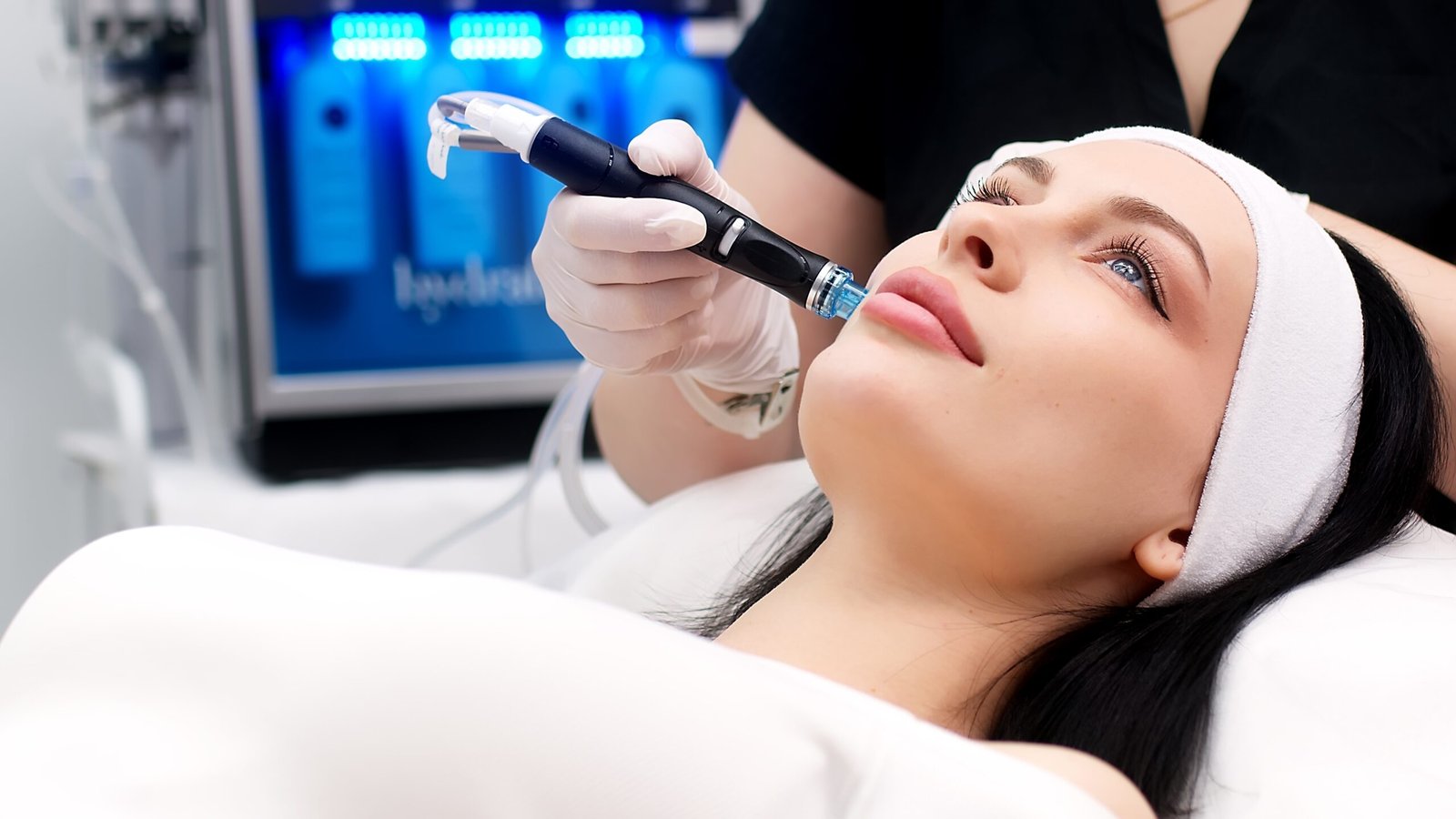In the pursuit of radiant and healthy skin, facials have long been a staple of skincare routines. Whether you’re looking for a quick refresh or a deeper treatment, facials offer numerous benefits to address various skin concerns. In Abu Dhabi, a growing number of people are turning to advanced treatments like HydraFacial, which promises instant results. But how does it compare to the traditional facial methods? This guide explores both options, helping you understand the key differences and what might be best for achieving glowing skin.
What Is a HydraFacial?
A HydraFacial Abu Dhabi is a state-of-the-art facial treatment designed to cleanse, exfoliate, extract, and hydrate the skin. This non-invasive treatment uses a patented device that combines cleansing, exfoliation, extraction, hydration, and antioxidant protection simultaneously. The process includes a gentle vacuum-like suction that helps remove dead skin cells, impurities, and debris, while delivering nourishing serums tailored to the needs of the skin.
HydraFacials are often popular for their ability to produce immediate results, leaving the skin looking brighter, more hydrated, and smoother. The treatment is suitable for all skin types, including sensitive skin, and targets a variety of concerns such as acne, fine lines, hyperpigmentation, and large pores..

What Are Traditional Facials?
Traditional facials are a more hands-on approach to skincare, often performed by licensed estheticians or dermatologists. The process usually begins with a skin analysis, followed by cleansing, exfoliation, extractions (if needed), facial massage, and the application of masks and serums. Depending on the skin type and concerns, the esthetician may use different techniques and products.
Traditional facials can vary in length, intensity, and customization, and are often tailored to address specific skin issues such as dry skin, acne, aging, or dullness. The overall goal is to cleanse, rejuvenate, and refresh the skin, leaving it feeling smoother and more balanced.
Key Differences Between HydraFacial and Traditional Facial
1. Treatment Process
The most significant difference between HydraFacial and traditional facials lies in the treatment process. HydraFacial uses a machine to provide multi-step treatments in one session, whereas traditional facials rely on manual techniques and topical products. HydraFacial combines exfoliation, extraction, hydration, and antioxidant infusion, all in a streamlined process. On the other hand, traditional facials typically involve a combination of manual cleansing, massage, and mask application, which can be less efficient in delivering the same level of deep hydration and exfoliation.
2. Targeted Skin Concerns
Both treatments target various skin concerns, but the way they address them can differ. HydraFacial is known for its versatility in treating a wide range of skin concerns, including acne, fine lines, wrinkles, and pigmentation issues. The treatment uses specific serums that are custom-blended for different skin needs, making it a highly personalized experience.
Traditional facials, depending on the products used, may not offer the same level of customization or versatility. While they can also address specific skin concerns, they often require multiple treatments or additional interventions to see the same level of improvement in specific conditions.
3. Duration and Convenience
HydraFacial is a quicker and more convenient option for those with busy schedules. The treatment typically lasts around 30 to 45 minutes, making it a great choice for individuals seeking a lunchtime boost without significant downtime. The instant results mean that you can walk out of the clinic with glowing skin, making it an ideal choice before special events or photoshoots.
Traditional facials generally take longer, usually between 60 to 90 minutes, depending on the type and complexity of the treatment. If you’re looking for a more relaxing and thorough skincare experience, a traditional facial might be the way to go. However, the longer duration and more involved steps can make it less convenient for individuals with time constraints.
4. Results
HydraFacial offers immediate, visible results. Skin appears smoother, more hydrated, and radiant right after the treatment, with the effects often lasting a few days to a week, depending on your skincare routine. Many people see a reduction in fine lines, improved skin texture, and even skin tone after just one session.
Traditional facials may not produce such dramatic results in a single session. While you may experience smoother, refreshed skin after a traditional facial, the results are usually less instant and may take a few days to show. To achieve more long-term effects, regular facials over time are often necessary.
5. Comfort Level
HydraFacial is often considered a more comfortable treatment compared to traditional facials. The process is gentle, with no pain or discomfort during the exfoliation or extraction phases, thanks to the machine’s gentle suction. Most people find HydraFacial relaxing, and there is no downtime involved.
Traditional facials can vary in comfort depending on the techniques used. Extractions, which are common in traditional facials, can sometimes cause discomfort, especially if your skin is sensitive or congested. However, many people enjoy the tactile experience of a traditional facial, including the facial massage and mask application, which promotes relaxation and a sense of well-being.
Pros and Cons of HydraFacial vs. Traditional Facials
HydraFacial Pros:
- Fast treatment time (usually 30-45 minutes).
- Immediate, visible results with no downtime.
- Suitable for all skin types, including sensitive skin.
- Highly customizable serums for specific skin concerns.
- Comfortable, non-invasive process.
HydraFacial Cons:
- Results may not be long-lasting without regular maintenance.
- Limited relaxing experience compared to traditional facials.
- Requires a clinic visit for the treatment.
Traditional Facial Pros:
- More personalized and relaxing experience.
- Suitable for a variety of skin concerns.
- Allows for deeper skin analysis and hands-on care.
- Can include elements like massage and masks that enhance relaxation.
Traditional Facial Cons:
- Longer treatment duration.
- Results may not be as immediate as with HydraFacial.
- May require more frequent treatments to see noticeable improvement.
Which One Should You Choose?
The choice between HydraFacial and traditional facials largely depends on your personal skincare needs, time constraints, and the type of experience you’re seeking. If you’re looking for quick, noticeable results with no downtime, HydraFacial might be the ideal option. Its convenience and efficacy make it a popular choice for those seeking fast improvements in skin texture and hydration.
However, if you prefer a more relaxing and therapeutic experience with a hands-on approach, traditional facials offer a wonderful alternative. They provide deep cleansing, soothing massages, and can be tailored to a wide range of skin types and concerns.
For those in Abu Dhabi, both options are available, and it ultimately comes down to what best fits your skin goals and lifestyle. Whether you opt for the cutting-edge HydraFacial or the classic approach of traditional facials, the goal is to achieve healthy, glowing skin.
FAQs
What is the main difference between HydraFacial and a traditional facial?
HydraFacial uses a machine to perform exfoliation, extraction, and hydration all in one session, providing immediate results. Traditional facials rely on manual techniques such as cleansing, massaging, and applying masks, often taking longer to deliver results.
How long do the results from a HydraFacial last?
HydraFacial results are visible immediately, with skin appearing smoother and more hydrated. However, the effects usually last for several days to a week, depending on your skincare routine and lifestyle.
Are there any skin types that should avoid HydraFacial?
HydraFacial is suitable for all skin types, including sensitive skin. However, it’s always recommended to consult with a skincare professional to ensure the treatment is suitable for your specific skin concerns.
How often should I get a traditional facial?
The frequency of traditional facials depends on your skin type and concerns. For optimal results, many people schedule facials once a month. Your esthetician can recommend a personalized plan based on your skin’s needs.
Can HydraFacial and traditional facials be combined?
Yes, it is possible to combine both treatments for enhanced results. Many people choose to undergo HydraFacial treatments to address specific skin issues and enjoy the relaxation and deeper cleansing benefits of traditional facials on a regular basis.



